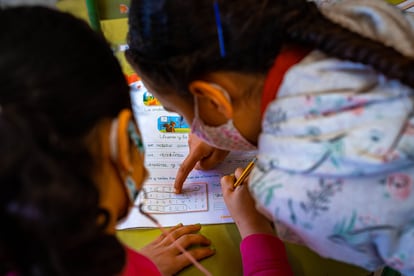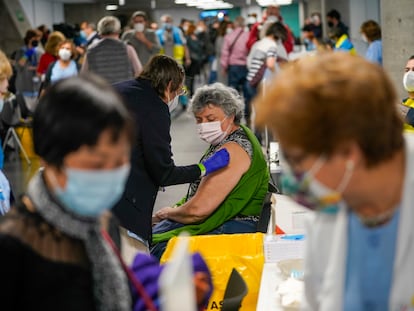Why have schools been able to stay open in Spain but not in neighboring countries?
According to a recent study, the country is one of the OECD nations where students have missed out on the fewest days of in-class learning

The image of primary schools and high schools opening every day independently of whether coronavirus cases are rising or falling has become the norm in Spain. But this situation is far from common. A recent report from the Organisation for Economic Cooperation and Development (OECD) ranked Spain as one of the OECD countries where students missed out on the fewest days of class in 2020. Since the beginning of this year, the contrast has become even starker: educational centers in Spain have remained open while nearly all neighboring countries have had to send home students at one point.
What’s more, despite the uptake in cases and the rising incidence rate following the Easter break, experts believe that it is unlikely that Spain will be forced to close schools in the third term, as teachers are being vaccinated against Covid-19 and the warmer weather is encouraging the natural ventilation of classrooms.
Spain ranked 10th out of 30 on the list of OECD countries that missed the fewest days of class in 2020, with around 50 days lost, depending on the school calendar of each region. And since the beginning of 2021, the nine countries that were ranked ahead have now experienced more problems than Spain. Denmark, Germany, Norway, Belgium, the Netherlands, Ireland and the United Kingdom were forced to temporarily suspend in-class learning; New Zealand closed all schools in Auckland, its largest city, in February and in France, schools have been closed under the country’s third lockdown.
How have schools in Spain been able to stay open?
According to experts, there are a number of reasons why schools in Spain have been able to stay open. These include strict protocols to prevent contagion, such as the use of face masks for students over the age of six, social-distancing measures and – as is the rule in most regions – the preventive quarantine of classes when a positive case is detected in a class bubble. A temperate climate (in comparison to that of other countries), which means windows can remain open, is also beneficial. Another factor is the broad consensus on the importance of in-class learning – a consensus that was strengthened by teachers’ negative experiences during the 2020 lockdown and the criticism of the decision to keep schools closed at the end of the last school year, when the epidemiological situation had improved and other activities were allowed to resume. Bars, for example, were allowed to reopen, while schools were not.
Hygiene protocols as well as the low contagion rates among children have also kept the number of coronavirus cases in schools low. At the end of the second term, only 0.4% of all classes in Spain were in quarantine. Public support for keeping schools open has meant that authorities have ruled out the arguments in favor of closures. In some countries, for example, it is argued that closing schools would reduce the mobility not only of students but also of parents.
Given the current epidemiological situation, experts don’t believe new school closures are likely. “Regardless of how much the incidence rate rises in the next weeks, it seems very unlikely that we will be worse than what we were in other waves,” says epidemiologist and pediatrician Quique Bassat. “What’s more, everything is in favor: warmer weather is coming and teachers are vaccinated. If we have held on until now, it would be very strange for [school closures] to happen,” she adds, explaining that there is currently no evidence that the new strains of the coronavirus increase transmission among children.
English version by Melissa Kitson.
Tu suscripción se está usando en otro dispositivo
¿Quieres añadir otro usuario a tu suscripción?
Si continúas leyendo en este dispositivo, no se podrá leer en el otro.
FlechaTu suscripción se está usando en otro dispositivo y solo puedes acceder a EL PAÍS desde un dispositivo a la vez.
Si quieres compartir tu cuenta, cambia tu suscripción a la modalidad Premium, así podrás añadir otro usuario. Cada uno accederá con su propia cuenta de email, lo que os permitirá personalizar vuestra experiencia en EL PAÍS.
¿Tienes una suscripción de empresa? Accede aquí para contratar más cuentas.
En el caso de no saber quién está usando tu cuenta, te recomendamos cambiar tu contraseña aquí.
Si decides continuar compartiendo tu cuenta, este mensaje se mostrará en tu dispositivo y en el de la otra persona que está usando tu cuenta de forma indefinida, afectando a tu experiencia de lectura. Puedes consultar aquí los términos y condiciones de la suscripción digital.
More information
Últimas noticias
‘Sleepless City’: The light of cinema illuminates Madrid’s Cañada Real shantytown
All the effects of gentrification in one corner of Mexico’s Colonia Roma
Palestinian reporter Youmna El Sayed: ‘My family told me I had to choose between being a journalist or a mother’
The new language of the workplace: Knowing how to ask AI questions is more important than using it
Most viewed
- Families demand repatriation of bodies of Colombians who died in Ukraine: ‘This war is a slaughterhouse for foreigners’
- The low-cost creative revolution: How technology is making art accessible to everyone
- Liset Menéndez de la Prida, neuroscientist: ‘It’s not normal to constantly seek pleasure; it’s important to be bored, to be calm’
- Christian Louboutin: ‘Young people don’t want to be like their parents. And if their parents wear sneakers, they’re going to look for something else’
- ‘El Limones’ and the growing union disguise of Mexican organized crime











































